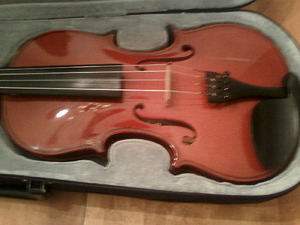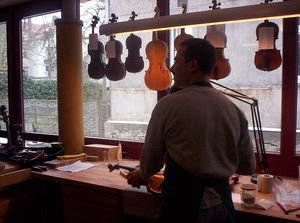Buying a Student violin
I shop around online a lot for music instruments and cheap deals because the best way to learn how to do Luthier work is to buy a few junk instruments and try to fix them up. A lot of the reviews for instruments priced around $50 through $100 are normally given very bad ratings because they say that it isn’t playable right out the box. After buying several cheap instruments from online ranging from wind instruments to guitars, to violins, I found that not all of them are as horrible as they may seem. A good example is the Vinci 4/4 Violin, it wasn’t perfect but with a bit of work it was pretty solid and had a nice sound.
Not everyone has the money to pay $500 and higher on a first instrument, so in this article I explain why the cheap violins might be worth looking into.
Common problems
Most “Cheap” violins I have seen start as low as $40 and go as high as $200, after that you will start going towards the higher end instruments. I would not recommend going under $70 to buy a violin because you will be pushing your luck at that point.
The reason most music companies are able to sell instruments so cheap (under $200) is because they are made out of lower quality woods, most have plastic or cheap wooden tuning pegs as well as low quality strings. These companies don’t put good strings on their instruments because it would raise the value of the violin and would increase the production price, so they expect the buyer to put better strings on it themselves to save a bit of money in their own pockets.
For a beginner you normally don’t need all the bells and whistles such as an ebony fingerboard and tuners (although they do help in the long run), the stock tuners normally will do just fine with a bit of adjustment. If you put new strings on your instrument that will greatly increase the sound quality of how your violin sounds and plays because most stock strings have been on there since the instrument was built.
The most common problems with cheap violins are-
1. The nut normally isn’t cut right and it causes intonation problems,
2. The bridge is not cut right and it causes intonation issues (or it falls out of place),
3. The tuners keep slipping and the instrument won’t stay in tune,
4. Bad cheap strings,
5. Cosmetic damage.
Alright, now that that is out of the way let’s look at how bad these cheap instruments really are. Even high end violins are not perfect when they leave the factory, they could cost over $2,000 and may still have a few of the problems named above and will still need a proper setup. The one thing you can count on is that there will normally be no cosmetic damage on your instrument.
You can ask any professional Luthier or musician anywhere and they will more than likely tell you “If you buy a new instrument go take it in to your tech guy to have it setup.”
A proper setup includes: fixing the nut and the bridge so that the strings sit properly and intonates well, putting on fresh strings to give it a better sound quality, adjusting the tuners so that they don’t slip out of place, and fixing any cosmetic damage (if needed) so that it looks appealing .
If it is needed the Luthier will also adjust the sound post for the best sound quality. This setup may cost you anywhere between $90 through $200. You might say “Well than I’ll just spend the extra $100 and get a better instrument to avoid this problem” yes you could, but that doesn’t guarantee that the higher priced instrument will already be setup when you buy it, meaning you could spend $500 on the instrument plus the additional $90 to have it setup. That isn’t including all the other extra accessories that you will need for practice as well. For a beginner instrument that can start to get costly.
Good deal for a low price
After buying several cheap instruments and giving them a setup the problems with them were actually fairly easy to fix. Most just needed some new strings and a better quality rosin, and a few tweaks to the tuners fixed it right up.The instruments base quality of how it was constructed was actually pretty solid (for a cheap instrument).
There are actually groups of people that specialize in repairing “VSOs” (Violin shaped objects) to turn them into real violins. The point is to pay very little money for the instrument and upgrading it into something playable.
Also, keep in mind that you will need to still care for your violin and make sure to keep the temperature and humidity levels comfortable to insure that the wood doesn’t crack from harsh weather conditions. Just because the violin is cheap doesn’t mean that it isn’t real, they are still constructed out of wood and need care. A common rule is- If the room is comfortable for you than it is comfortable for the instrument.
If you get a cheap violin and it is badly damaged where it has cracks in it then it is best to return it and get a replacement because it isn’t worth fixing. If it has minor flaws like the ones named above it might be best to keep it because you can still make it work after getting it setup. If your bridge is bad you can actually buy a pre-cut bridge and use it for your violin, and a few drops of rosin on the tuning pegs will keep them from slipping. Fine tuners won’t hold? You can order new ones for as low as $7.
If you spend around $80 for the violin and the setup costs you around $90, in total you will spend about $170 for your instrument. If you decide you don’t like the violin and you give up playing at least you didn’t spend half a grand on it. Most of my cheap instruments have lasted longer than two years and sound good enough to play in a group, so I don’t look at them as being a waste of money. Since most of these cheap instruments are “Violin” shaped you can still use them to learn the basic fingering positions to learn all the notes to practice with them.
If you decide to stick with playing the violin for the first few years you can always upgrade to something better in the future without breaking the bank when starting out. If you have the money to afford them, the average quality starter violins start at around $200 through $300 and will go higher from there. They are normally made with proper ebony tuners and tailpiece fittings, and a higher quality aged wood for a better sound quality.
If you do decide to buy a “VSO” or you already own one, here is a link that might help you fix it up:
How to get the Best Sound Quality for Violin.


